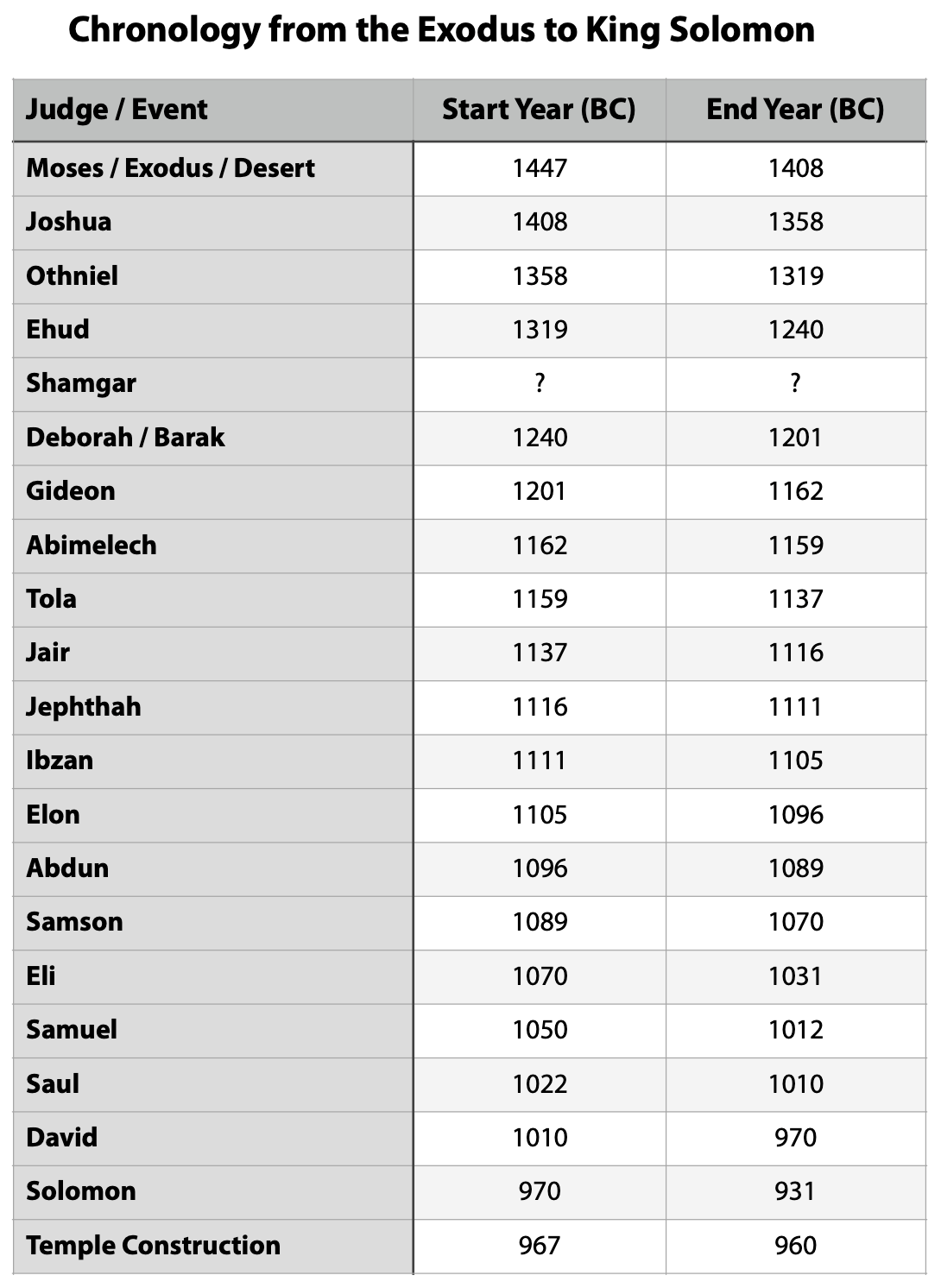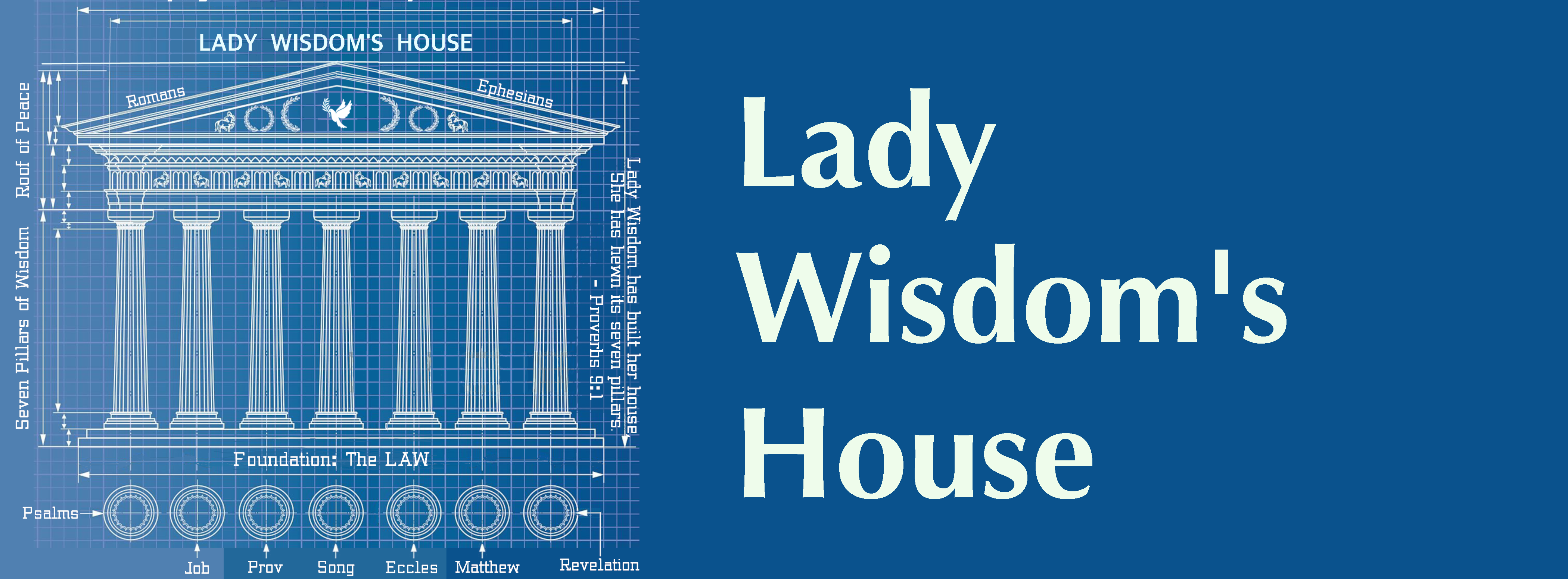Chronology of Judges
1871 words long.
Published on 2024-05-09
This article is a distillation of the reasoning set forth in two chapters of Plague, Precept, Prophet, Peace. The chapters are titled "Job’s Anti-jubilee Clock, Defined" and "Prophecies from Abraham to David: Job 1-20".
Establishing a consistent chronology of the time of the Judges is one of the thorniest puzzles in the Bible. Reconstructions of the length of this period in history based on different assumptions differ by hundreds of years. Any attempt to unify all of salvation history into a single chronological and prophetic framework must solve this problem. The problem is both over- and under-constrained. Here are some of those constraints and problems associated with them:
- Years of Service. The length of service for each judge is given throughout Judges.
- Years of Oppression. The length of time that Israel was oppressed by each enemy is given throughout Judges.
- Overlap or Gaps? We are not told if any judgeships overlapped or if there were gaps between them.
- Exodus to Temple. The length of time from the Exodus to the laying of the temple foundation by Solomon (which encloses the time of the judges) is given as 480 years in 1 Kings 6:1.
- Jordan Crossing to Jephthah. The length of time from the crossing of the Jordan (or maybe a different event near then) to the time of Jephthah is given as 300 years in Judges 11:26.
- Saul's Reign. The length of King Saul's reign is given as forty years in Acts 13:20-21 (though alternate interpretations dispute that).
- Joshua's lifespan. Joshua lived 110 years as given in Joshua 24:29, but we are never told explicitly how old he was at the time of the Exodus or any other event, so do not know how long he led Israel after Moses died.
Add everything? A naive reading of Judges encourages you to think that there were alternating periods when there were judges and when there was oppression. If you add up the lengths of the judgeships and the lengths of the periods oppression, you get a number much larger than the time frame given in 1 Kings 6. Thus we cannot add everything up to get a simple answer.
Add only judgeships? If you assume that the times of oppression were carved from the time of the previous judge and just add the lengths of the judgeships, the total length of the era falls short.
Simple approaches that vary a single assumption fail to establish a useful timeline. Over the centuries, many solutions have been proposed for parts of the problem. Some solutions conflict with others. Assembling a complete and consistent set of rules that match all the known constraints and do not do injury to the Biblical text is not simple. This article will propose a set of assumptions and work out a timeline for the judges from them. Only one of the ideas is my own. Even omitting that idea, the collection of the remaining solutions into one framework is new. I have not seen any authors who employ all and only these assumptions.
These sources were helpful in my research, though I did not adopt all of their ideas:
- Osgood, Dr. A.J.M. The Times of the Judges – A Chronology, Ex Nihilo Technical Journal, vol. 1, 1984, pp. 141-158.
- Schatz, Elihu A. The Length of the Rule of Joshua and the Periods of Subjugation in the Book of Judges.
- Todd. “Saul”. The Biblical Timeline.
Rule 1: Omit the Years of Oppression
Whenever Israel was oppressed by an enemy, the length of that oppression is given. We shall assume that the years of oppression are carved out of the latter years of the previous judge. Since such dark times overlap the time of a judge, we do not need to add them to the total for the era.
Rule 2: Israel (almost) always had a Judge
There were no gaps between judges, with one exception. The sole exception is the three year period when Abimelech usurped power and slaughtered his rival family members. He was not an approved judge, so while he ruled, there was a gap in the rule of the judges.
Rule 3: Overlapping transitions.
We shall assume each year when one leader died matches the year when the next began their office. All transition years are double-counted. This is consistent with a “non-accession year” chronology using Edwin Thiele's terminology. (This correction IS my idea, borrowed from ideas that Edwin Thiele applied to the era of the kings.)
Rule 4: Judgeships did not overlap
Dr. Osgood noted that some judges drove out enemies to the south, while others drove out enemies to the north. This permitted him to theorize that some judgeships were overlapping, with a northern judge and a southern one. I did not need to employ this assumption, but it is worth noting.
There is one exception to this rule. No length of service is given for Shamgar. Possible interpretations of this:
- The information has been lost, so our chronologies will be off.
- Shamgar's rule lasted less than a year, so they did not count it.
- Shamgar's rule did overlap the rule of another judge, so the years of his rule were not counted, in order to not add another confusion to to the record of the judges.
Rule 5: Joshua was a teen during the Exodus
Most people assume that Joshua was about the same age as Caleb, his spy partner and right hand man. This assumption leads to a short estimate for the length of his time leading Israel. Following is a quote from Plague that addresses this. It used a date of 1407 BC for the Jordan crossing, while Dating the Creation uses 1403 BC. I am still working out where to insert all the one year rounding corrections to make everything line up.
In 1407 BC, Joshua crossed the Jordan at the head of a jubilant people. He would live to 110. There is a debate over how long he ruled Israel. Joshua and Caleb were the only two spies for Moses with the faith and courage to recommend that the people begin their conquest. Thus people assume his age was similar to Caleb’s and Caleb was forty during the second year in the desert (Joshua 14:7). By that reckoning, Joshua was near forty at the time of the Exodus and eighty when he crossed the Jordan. This would mean he ruled 28-30 years. However, Elihu A. Schatz argues that Joshua was nineteen years old at the time of the Exodus and twenty years old almost two years later when the spies were sent out.
Schatz offers three main reasons:
- Joshua would be too old (89) to lead the arduous military campaigns in Joshua 10 & 11.
- If Joshua only ruled twenty-eight years, the chronology of the Judges requires that two times of subjugation and only two were times when Israel had no ruling judge, 7 years to Midian in Judges 6:1 and 18 years to the Ammonites, in Judges 10:7-8.
- Joshua would have to have been exempt from a curse where no such exemption is given to him by name. The only exemption that would apply to him would be if he were younger than twenty years of age.
The third is the one that cinches it for me. To quote Schatz:
Only Caleb was specifically excluded from the punishment
meted out to those who were 20 at the time of the Exodus
(Num. 14:24), while both Caleb and Joshua were excluded
from the punishment inflicted on those who were 20 in the
second year in the desert (Num. 14:30). This proves that
Joshua was 19 years old at the time of the Exodus and
20 years old in the second year of the desert, when he was
sent to "spy out the land."
From this it may be concluded that Joshua was 59 when he assumed leadership, therefore served from fifty to fifty-one years, roughly one Jubilee cycle. Therefore the man ruled God’s people for the entirety of this generation.
Rule 6: Samuel's Judgeship overlapped with Eli's
Samuel began his judgeship twenty-eight years before Saul was anointed king, during the waning years of Eli.
Rule 7: Saul Ruled Israel for Twelve Years, not Forty
Saul reigned 12 years. The author of the Bible Timeline observed that the Ark of the Covenant was captured two years before Saul became king. After it was recovered months later, it remained in Kiriath-Jearim for twenty years. (See 1 Samuel 7:1-2.) It was David who arranged for it to be carried from Kiriath-Jearim to Jerusalem in the seventh year of his reign. (See 1 Chronicles 13.) This puts an upper limit of twelve years on Saul’s reign.
To reconcile this with Acts 13:20-21, the assumption is that it was the collective rule of both Samuel and Saul that lasted forty years.
Rule 8: Brief Coregency of David and Solomon
There is evidence that Solomon had two coregencies with his father David. The first was a subordinate coregency of perhaps three years. This is not shown. The second is a one year equal coregency. That will be respected.
The Timeline
Now you can judge how good a job I have done when counting judges...
Note how each judge begins his or her rule during the final year of the previous judge. The following table is taken straight from Plague, Precept, Prophet, Peace.

Jephthah's Speech and the 300 Years
If you look closely, you will see that this timeline seems to violate the constraint from Jephthah's speech. He notes a 300 year period from some event in the past until the day he was speaking. If that starting event was the crossing of the Jordan, then the 300 year period would end three years after Jephthah's rule ended. Possible solutions are:
- Jephthah's number was an approximation, so this timeline is okay. This would be an unusual thing to find in the Bible.
- We need to add three or more years for Shamgar (for whom we have no count of years) to make up the difference, then remove the same number of years of overlap between Samuel and Eli to bring all constraints into balance.
- Jephthah was referring to an event during the wandering in the desert prior to the Jordan Crossing.
Israel did come into possession of some territory before Joshua crossed the Jordan, so the third solution is possible.
Now are you any better than Balak the son of Zippor, king of Moab?
Did he ever contend against Israel, or did he ever go to war with them?
While Israel lived in Heshbon and its villages,
and in Aroer and its villages, and in all the cities that are on
the banks of the Arnon, 300 years, why did you not deliver them
within that time?
- Judges 11:25-26
The story of Balak is given in Numbers 22. Those events did occur before Moses died, though I am not sure how long. Thus it is likely that Jephthah's measurement of 300 years refers to an event that precedes the crossing of the Jordan. Therefore, there may be no contradiction. This speech of Jephthah therefore further validates the assumption that Joshua was 19 when the Exodus occurred and that the years of oppression should not be added.

